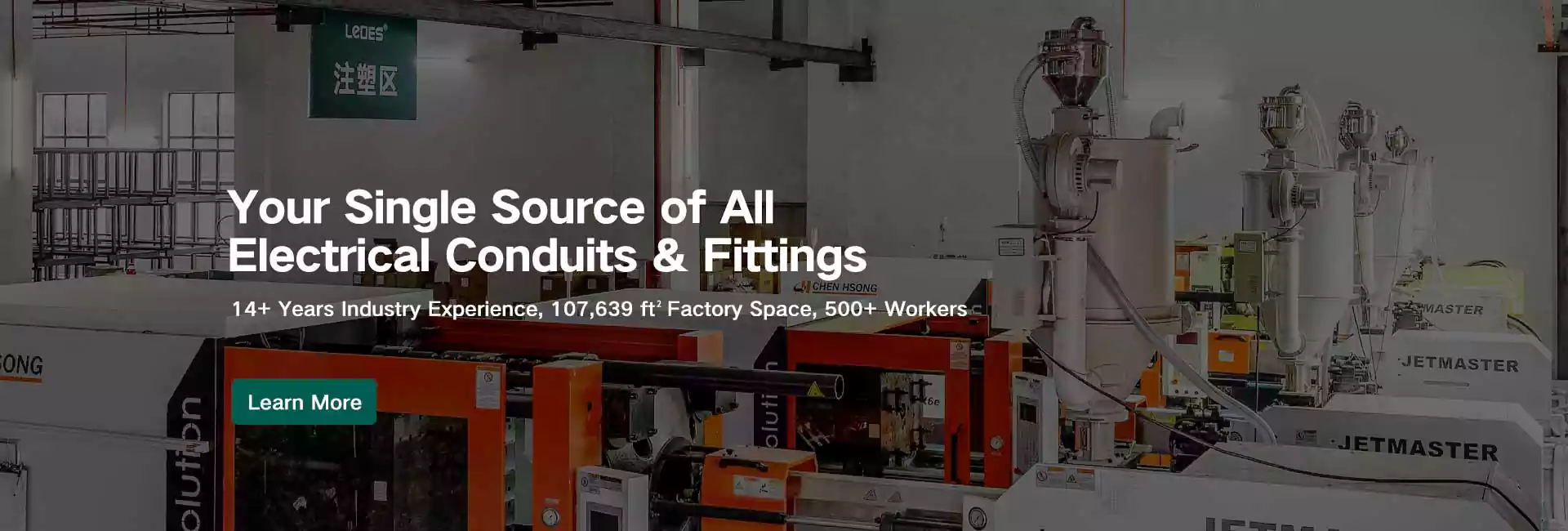
목차
1. Introduction
When planning an EV charger installation, it’s easy to focus on the charger itself — its power output, brand, or smart features. But behind every successful installation lies an essential yet often overlooked element: the conduit system.
A conduit is a protective pathway that houses electrical wiring, shielding it from physical damage, moisture, and other environmental factors. In EV charging systems, conduits play a crucial role in ensuring that electrical connections remain safe, reliable, and code-compliant throughout the system’s lifespan.

Conduit use isn’t just about protection — it’s also about organization and safety. By routing wires through a defined path, conduits reduce the risk of accidental contact, improve accessibility for maintenance, and help installations meet the National Electrical Code (NEC) or Canadian Electrical Code (CEC) standards. For residential garages, parking lots, or commercial charging hubs, choosing the right conduit layout can make the difference between a clean, professional setup and a cluttered, unsafe one.
Importantly, how the conduit is installed — whether hidden within walls or exposed on surfaces — affects not only aesthetics but also cost, flexibility, and maintenance. Understanding these differences is the foundation for making informed design choices in your EV charger project.
By reading this post, whether you are a homeowner, a facility manager, or an EV charger installer, you will learn:
- The differences between hidden and exposed conduit systems in EV charger installations.
- How each option affects installation complexity, appearance, and maintenance.
- The advantages and limitations of both conduit types in real-world residential and commercial scenarios.
- Practical guidance to help you choose the most suitable conduit layout for your EV charging setup.
2. Hidden Conduit for EV Chargers: A Clean and Protected Installation
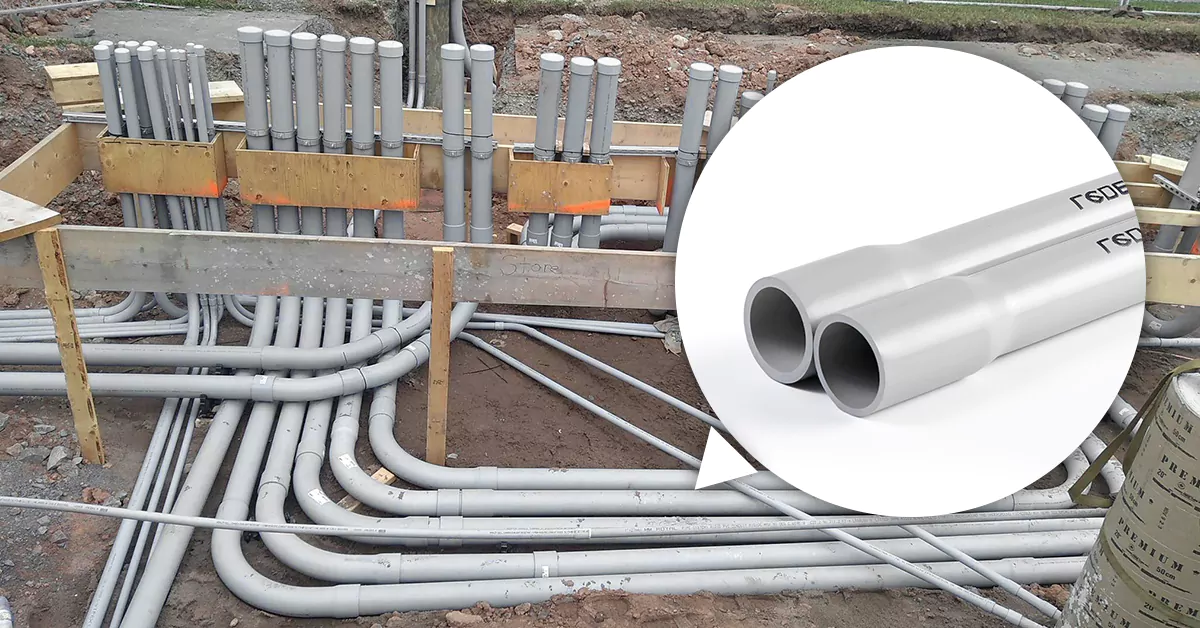
When it comes to installing an EV charger, many homeowners and developers prefer a clean, seamless look — one where cables are invisible and the wall remains visually uncluttered. This is where hidden conduit installation, also known as concealed wiring, plays its role. In this setup, the electrical conduit is routed inside walls, ceilings, or underground, keeping it completely out of sight.
What Hidden Conduit Actually Means
Hidden conduit refers to the installation method where PVC or EMT conduit is embedded within concrete, drywall, or underground pathways before the final finishing of the structure.
In residential settings, this often means the conduit runs behind the garage wall or through the slab before the wallboard is installed. In commercial sites or public charging stations, it can be routed beneath the pavement or inside columns for a neat architectural finish.
Because the conduit is not accessible after installation, every bend, junction box, and connection must be planned and fixed in advance. The system becomes part of the building’s infrastructure — durable and permanent, but not easily altered.
Advantages of Hidden Conduit in EV Charger Installations
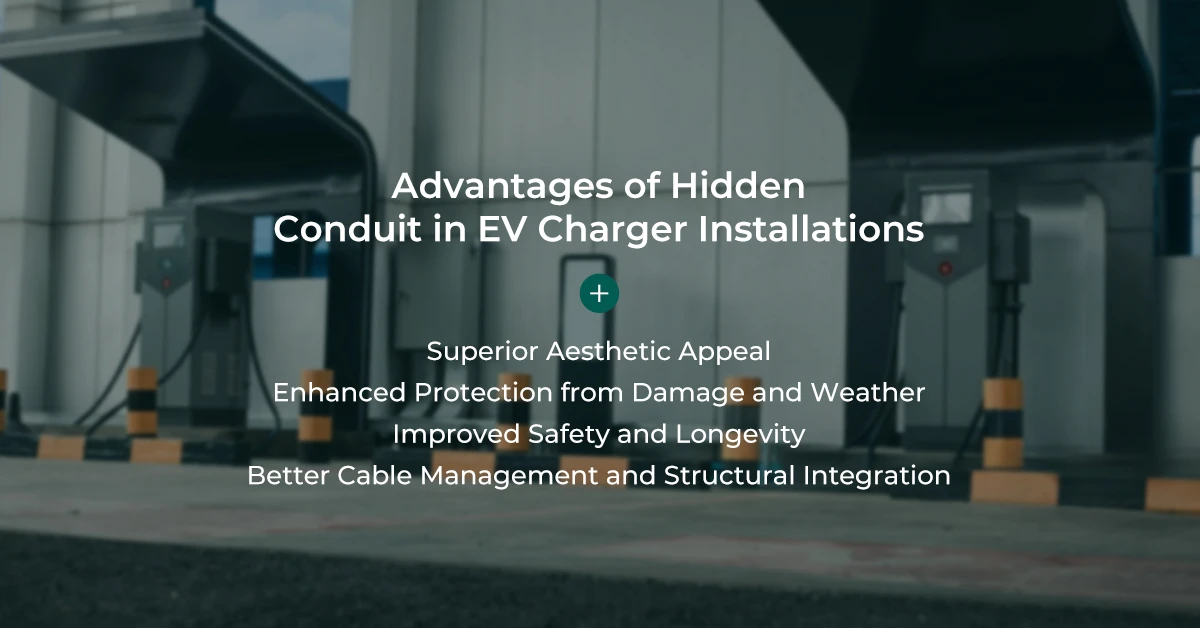
Superior Aesthetic Appeal
Hidden conduit installations are visually unobtrusive, maintaining a clean and high-end appearance. For new residential garages or retail parking structures, the absence of visible conduit enhances both property value and visual harmony, especially when EV chargers are integrated into architectural design.
Enhanced Protection from Damage and Weather
Since the conduit is shielded behind walls or beneath surfaces, it’s less exposed to physical impact, UV light, or moisture. This makes it ideal for long-term reliability in harsh environments or outdoor setups where weather resistance is essential.
Improved Safety and Longevity
Concealed systems minimize the risk of accidental damage or tampering — an important consideration for public-access charging areas. Properly installed buried conduit also reduces the likelihood of corrosion or mechanical wear, extending the lifespan of the installation.
Better Cable Management and Structural Integration
Hidden conduit allows cables to be routed logically through building frameworks. This not only helps maintain code compliance but also simplifies grounding and bonding when planned correctly during the construction phase.
Challenges and Considerations
While hidden conduit offers clear advantages, it also comes with significant planning and cost implications.
Installation Cost and Labor: Because the conduit must be embedded before surfaces are finished, labor and material costs are higher. Retrofitting hidden conduit into existing buildings often requires wall demolition or concrete trenching.
제한된 접근성: Once walls are sealed, maintenance or upgrades (e.g., moving to a higher charger amperage or adding new outlets) become complex and costly.
Precise Planning Required: Electricians must predefine conduit routes, junction points, and box placements before construction begins. Any oversight could delay project schedules or require reconstruction.
When Hidden Conduit Makes the Most Sense
Hidden conduit is most suitable when:
The EV charger is part of a new home or commercial build, allowing conduit routes to be embedded from the start.
The appearance of the installation is a design priority — such as premium residential garages, corporate facilities, or showrooms.
The installation is permanent and expected to remain unchanged for many years.
The site is exposed to harsh conditions (e.g., direct sunlight, public access) and needs extra protection against wear or vandalism.
3. Exposed Conduit for EV Chargers: Practical and Flexible Installation
While hidden conduit installations deliver a sleek, integrated finish, not every project has the budget, timeline, or structure to make that possible. In many retrofit or commercial settings, exposed conduit installation becomes the more practical and adaptable option. In this method, the conduit runs visibly along walls or ceilings, securely fastened with straps, clamps, or mounting brackets, and typically connects directly to a surface-mounted junction box or charger enclosure.
What Exposed Conduit Installation Involves
Exposed conduit, sometimes referred to as surface-mounted wiring, is installed on top of existing walls or structures, without embedding it into concrete or drywall. It is common in retrofit EV charger projects, older buildings, or parking areas where running conduit through the wall is impractical or not permitted by building constraints.
For example, in a residential retrofit, the electrician may route PVC Schedule 80 or 40 or IMT/RMC conduit along the garage wall to connect the power source to the EV charger. In commercial applications, such as parking decks or warehouse facilities, RMC or IMC conduit might be chosen for its strength and resistance to impact.
Advantages of Exposed Conduit
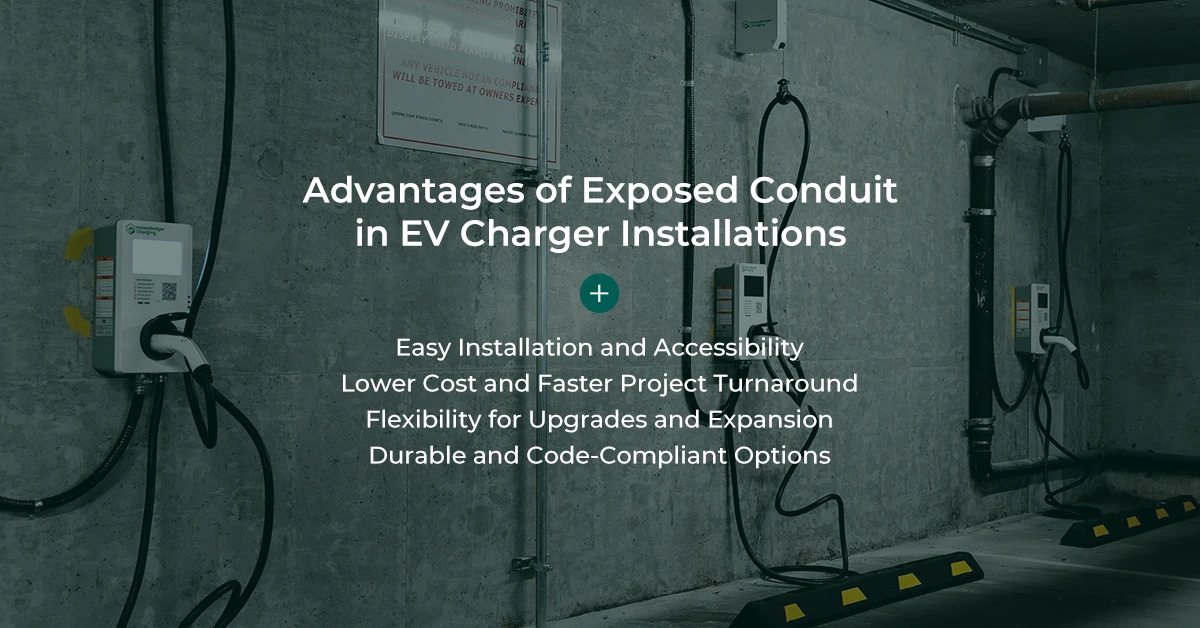
Easy Installation and Accessibility
Exposed conduit is much faster to install, as it doesn’t require cutting into walls or pouring new concrete. Electricians can measure, bend, and secure conduit directly onto the surface, significantly reducing labor time.
Accessibility is another major benefit — any future maintenance, upgrades, or repairs can be carried out without structural work.
Lower Cost and Faster Project Turnaround
Because exposed systems require fewer construction steps, overall project costs are lower. For homeowners adding an EV charger post-construction, or contractors outfitting a fleet parking lot, exposed conduit can make installation financially viable while still meeting safety codes.
Flexibility for Upgrades and Expansion
As EV charging technology evolves, flexibility becomes essential. Exposed conduit allows contractors to add new circuits or reroute power lines easily — ideal for growing commercial sites or shared charging facilities.
Durable and Code-Compliant Options
Exposed conduit doesn’t mean unprotected. PVC, EMT, and metal conduit types can all be used in exposed setups, provided they meet local codes for mechanical protection, grounding, and UV resistance.
For outdoor applications, PVC Schedule 80 is often preferred due to its corrosion resistance and UL 651 compliance, while metal conduit types are used when higher mechanical protection or grounding continuity is required.
Challenges and Limitations
Despite its practicality, exposed conduit systems also have drawbacks that need to be weighed carefully:
Aesthetic Considerations: Visible conduit runs may not fit with modern interior design or luxury garage aesthetics.
Potential for Damage: Being exposed means greater risk from accidental impact, corrosion, or vandalism, especially in public or high-traffic areas.
Environmental Exposure: Outdoor runs must be properly sealed and supported to prevent water ingress, UV degradation, and thermal expansion issues.
Where Exposed Conduit Works Best
Exposed conduit installations are ideal when:
The EV charger is added after construction, such as in existing homes, parking lots, or garages.
Budget and time constraints are major considerations.
The site environment allows visible conduit routing without affecting safety or usability.
Future scalability — adding more chargers or higher load capacity — is a likely scenario.
4. Hidden vs. Exposed Conduit: How to Choose the Right Option for Your EV Charger
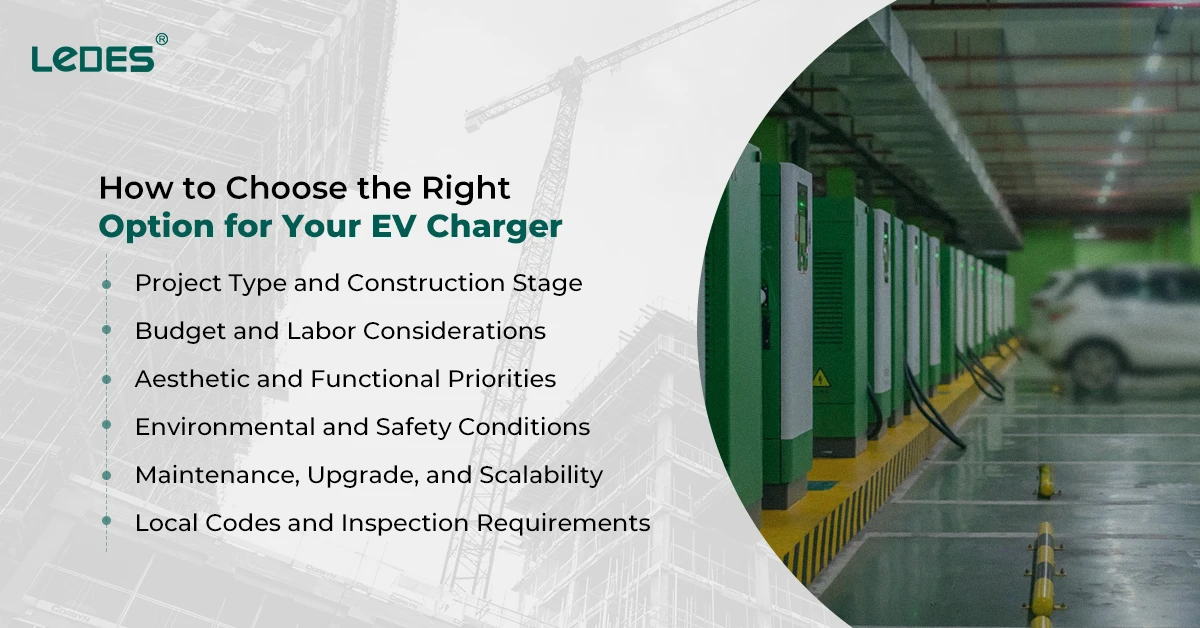
Now that you understand what each conduit type involves, the next step is deciding which installation method fits your EV project best.
Both hidden and exposed conduits are fully compliant with electrical codes and can deliver reliable performance when installed properly.
Let’s break down the most important factors that determine your choice.
Project Type and Construction Stage
The first and often most decisive factor is whether your EV charger is being installed during new construction or as part of a retrofit project.
For new construction, hidden conduit is the clear winner. Since walls and floors are still open, conduit can be embedded easily during rough-in, creating a clean and permanent result. Developers and architects often specify concealed conduit for aesthetic consistency and future-proofing.
For retrofit or existing buildings, exposed conduit is almost always more practical. It avoids wall demolition and enables fast installation without disrupting finished spaces. For home garages, commercial parking structures, or fleet retrofits, surface-mounted conduit saves both time and cost.
Budget and Labor Considerations
Financial factors play a major role — conduit choice directly affects total installation cost.
Hidden conduit generally comes with higher labor costs, longer installation times, and potentially more materials (junction boxes, concrete cutting, patching). It is best suited for long-term, permanent setups where aesthetics justify the expense.
Exposed conduit, on the other hand, is more cost-effective and flexible, particularly for short lead times or phased installations. Materials are similar, but less manpower and construction coordination are needed. In short: hidden conduit is a design investment; exposed conduit is an operationally efficient solution.
Aesthetic and Functional Priorities
If your EV charger is installed in a visible or premium location, aesthetics might outweigh convenience. For residential garages, hotels, or retail facilities, hidden conduit keeps walls visually clean and aligns with modern design expectations.
In industrial or parking structures, functionality and durability matter more than appearance — here, visible conduit runs are acceptable and even expected. Put simply, choose hidden conduit when design matters, and exposed conduit when efficiency matters.
Environmental and Safety Conditions
Environmental exposure can also guide your decision.
For outdoor or high-impact areas, exposed conduit (PVC Schedule 80 or metal types) can handle mechanical stress and weather better when properly supported.
Indoor or protected locations benefit from hidden conduit, which is safer from tampering, vandalism, and environmental degradation. Both systems can meet NEC (National Electrical Code) standards when installed correctly — the difference is in how they protect the wiring under real-world conditions.
Maintenance, Upgrade, and Scalability
If you foresee future upgrades — for example, switching from a 40A charger to an 80A charger or adding more charging points — exposed conduit offers a clear advantage.
You can easily reroute cables, add junctions, or expand capacity. Hidden conduit, while durable, requires structural work for any modification, making it less flexible in evolving systems.
Local Codes and Inspection Requirements
Some jurisdictions have specific conduit requirements based on seismic safety, fire rating, or accessibility. Always consult a licensed electrician or local authority having jurisdiction (AHJ) before finalizing your design.
In most North American contexts, both hidden and exposed conduit types are allowed — as long as they use UL Listed materials (e.g., UL 651 PVC conduit) and are installed per NEC standards.
전문가 팁: 더 자세히 알고 싶으신가요? expert tips & code details to choose the electrical conduit for an EV charging station? Click the above link to read our last post.
5. Professional Tips for a Safe and Code-Compliant EV Charger Conduit Installation
Choosing between hidden and exposed conduit is only part of the equation — proper installation practices determine whether your EV charger system performs safely and reliably for years to come.
Use Code-Compliant Materials
The foundation of any safe EV charging setup starts with certified conduit and fittings.
For nonmetallic conduit, look for products like marked UL 651 — covering Schedule 40 and Schedule 80 PVC rigid conduit.
For ENT or flexible nonmetallic options, ensure they meet UL 1653 if used indoors or in protected concrete walls.
For metallic conduit, UL 1242 (IMT) or UL 6 (RMC) listings are essential.
Using compliant products not only guarantees mechanical and fire safety but also simplifies the AHJ inspection process, helping your installation pass on the first try.
참고사항: Know more about the 4 international standards & codes for EV charging stations here.
Match the Conduit Type to the Environment
Environmental factors — moisture, UV exposure, and mechanical stress — directly affect conduit performance.
For outdoor installations, PVC Schedule 80 offers superior UV resistance and impact strength. Protect all terminations with liquid-tight fittings and seal entries with appropriate gaskets or bushings to prevent moisture ingress.
Indoor or protected spaces often only require Schedule 40 PVC or RMC, provided runs are not exposed to heavy mechanical impact.
For underground runs, choose PVC conduit that can be buried like or Schedule 40/80 and warning tape to comply with NEC 300.5.
Plan Conduit Routes Before Installation
Efficient conduit routing reduces material waste and installation complexity.
Keep runs as straight and short as possible to minimize voltage drop and simplify cable pulling. Limit the number of 90-degree bends — NEC allows up to 360° between pull points, but fewer bends make maintenance easier.
In hidden systems, pre-mark all junction boxes and bends before pouring concrete or finishing walls, as rework becomes costly once surfaces are sealed. A well-designed layout not only improves safety and functionality but also reduces labor hours.
Secure Proper Support and Spacing
Loose or improperly supported conduit can strain fittings and compromise long-term stability. For PVC conduit, supports are typically required within 3 ft (0.9 m) of each box or fitting and every 3 ft thereafter. For metal conduit (EMT/RMC), support intervals can extend to 10 ft (3 m), depending on local code. Always use corrosion-resistant straps or clamps, and avoid overtightening to prevent cracking nonmetallic conduit.
Use Proper Connectors and Expansion Fittings
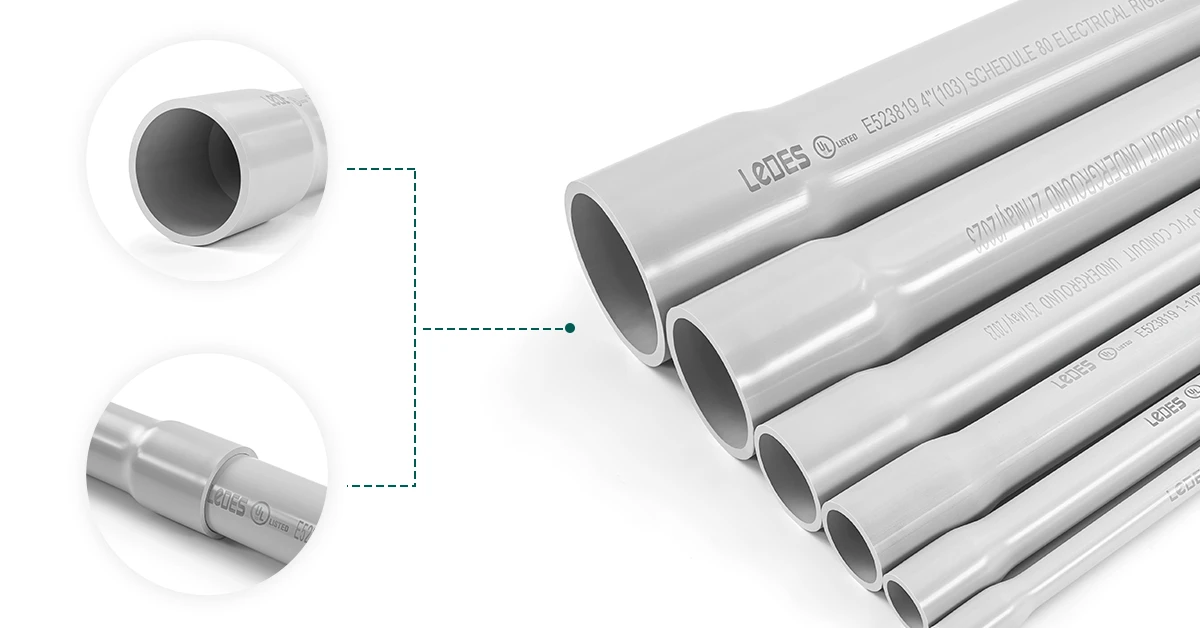
Thermal expansion can significantly affect PVC conduit, particularly in outdoor or rooftop installations. Incorporate expansion joints in areas subject to frequent or extreme temperature changes to prevent stress on the conduit.
Apply solvent cement or threaded fittings per manufacturer instructions, as improper bonding is a common failure point.
For exposed conduit runs, always seal threaded fittings with approved compounds to maintain watertight integrity.
Grounding, Bonding, and Inspection
Proper grounding ensures fault currents are safely carried back to the source, preventing shock hazards.
Metal conduit systems often serve as the grounding path, so ensure all joints are tight and conductive.
PVC systems require separate copper or aluminum grounding conductors inside the conduit.
Before energizing the EV charger, conduct a continuity test and have the installation inspected by a licensed electrician or AHJ.
Coordinate with EVSE Requirements
Different EV chargers (EVSE units) have varying power ratings and installation requirements.
Verify breaker size, cable gauge, and conduit fill capacity against the charger’s specifications.
Plan for future upgrades — using one conduit size larger than required can save major rework later.
Ensure disconnect switches, junction boxes, and mounting heights comply with local codes and manufacturer recommendations.
6. Conclusion: Choosing the Right Conduit for Your EV Charger Installation
Installing an EV charger involves more than selecting the right unit — the conduit system you choose is critical to the safety, durability, and overall appearance of your installation. This article has explored the differences between hidden and exposed conduit, highlighting their advantages, limitations, and practical applications.
Hidden conduit offers a clean, integrated look with excellent protection, making it ideal for new construction, premium residential garages, or commercial facilities where aesthetics and long-term durability are priorities. Exposed conduit provides flexibility, easier maintenance, and cost efficiency, making it well-suited for retrofit projects, industrial settings, or locations where future upgrades are likely.
When deciding between hidden and exposed conduit for your EV charger installation, it is important to consider factors such as project type and construction stage, budget and labor constraints, aesthetic and functional priorities, environmental exposure and durability needs, maintenance and scalability requirements, and local electrical codes and safety regulations.
By carefully weighing these considerations and following professional installation best practices, you can ensure a safe, code-compliant, and reliable EV charger system — one that meets both current requirements and future demands.
Ledes 소개
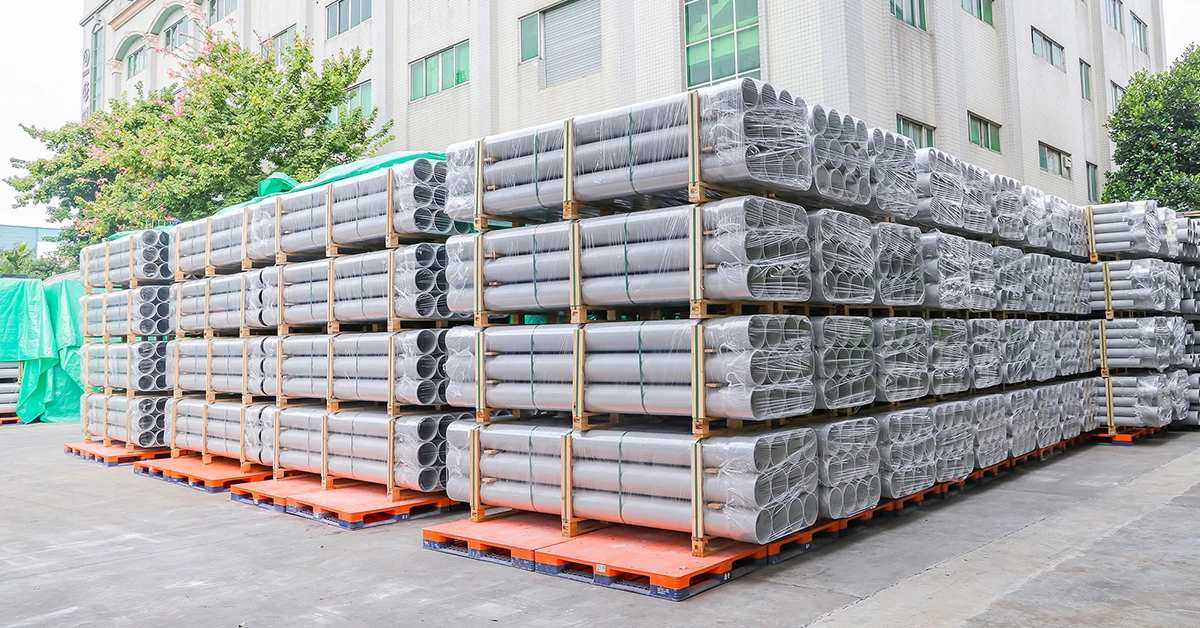
레데스 is a leading manufacturer and supplier of high-quality electrical conduit and fittings for residential and commercial applications.
With decades of experience, Ledes provides PVC conduit with different certifications, including rigid flexible conduit options, designed for durability, safety.
Whether planning a new EV charger installation or upgrading an existing system, Ledes offers trusted products and technical support to help you achieve professional, reliable results.
Contact our business team if you are ready to start your project today!
자주 묻는 질문
What is the difference between hidden and exposed conduit for EV chargers?
Hidden conduit is installed inside walls, ceilings, or under slabs, keeping cables out of sight, offering a clean look and extra protection. Exposed conduit runs on the surface of walls or ceilings, making installation faster, maintenance easier, and future upgrades more flexible.
Which type of conduit is better for new construction?
Hidden conduit is usually the preferred choice for new builds because it can be integrated during rough-in, providing a seamless, aesthetic installation while protecting the wiring from damage.
Is exposed conduit suitable for retrofitting EV chargers?
Yes. Exposed conduit is ideal for retrofit projects where walls or floors are already finished. It allows quick installation without demolition and makes future upgrades or maintenance easier.
What materials are recommended for hidden and exposed conduit?
Hidden conduit: Schedule 40 or 80 PVC, RMC, IMC — chosen for durability, corrosion resistance, and code compliance.
Exposed conduit: PVC, EMT, or metal conduit depending on environmental exposure, mechanical protection, and aesthetic needs. Always choose UL-listed and code-compliant products.
How do I choose the right conduit size for my EV charger?
Conduit size depends on the cable type, number of conductors, and ampacity requirements. Hidden conduit often benefits from a slightly larger size to ease cable pulling and future upgrades. Exposed conduit may allow more flexibility with bends and pull boxes. Consulting a licensed electrician is recommended.
Can I switch from hidden to exposed conduit later?
Technically yes, but hidden conduit is usually embedded in walls or slabs, making retrofitting expensive. Exposed conduit is much easier to modify, expand, or reroute if power needs change.
Do local electrical codes affect hidden vs exposed conduit choice?
Yes. Both types must comply with NEC, local building codes, and inspection requirements. Some codes may dictate specific materials, burial depth, or mechanical protection. Always check with your licensed electrician or AHJ before installation.


